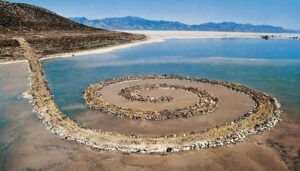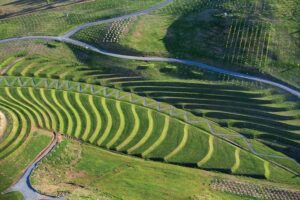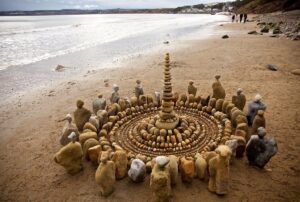Land art- Introduction
Land art, also referred to as Earth art or environmental art, is an artistic movement that emerged during the late 1960s and early 1970s. It involves creating artworks within the natural landscape, utilizing natural materials like rocks, soil, and vegetation. Land art aims to challenge the traditional confines of art spaces and redefine the relationship between art, nature, and the viewer.
Land art- Introduction through upper written categories
These two above written categories, “Culture” and “Philosophy” comprise an essential aspect of the life of this artist. Land art is an art style of elite class which played a vital role in the Land art renaissance movement.
You would know these things in this article:- Contemporary land artists & Forms.
There are other art movements such as “Harlem renaissance,” “Expressionism,” and “Bauhaus” which are similar to some extent.
Some artists of Land art come from other art styles such as Andy Goldsworthy, Robert Smithson, Richard Long, Michael Heizer, and Walter De Maria.
This art movement (Land art) has many famous paintings/artworks such as “City,” “Little Sparta,” and “Not A Cornfield.”
If you see the beauty of these paintings, then “Spiral Jetty” comes at first place which is beautiful, “Double Negative,” sometimes comes at the second place due to its demand.
If you (As a/an Land art student) really want to read comprehensively then read these sections– “Culture (artistic approach)” and “Philosophy (Other aspects).”
These categories comprise in-depth knowledge, especially- “Culture”-A Category.
LAND ART was an art movement, and if you want to read about Land art comprehensively, then you should also cover its most famous artist– Andy Goldsworthy, Robert Smithson, Richard Long, Michael Heizer, and Walter De Maria.
But if you have less time, then you may select- Land art Characteristic section.
Land art- Characteristics
Land Art, also known as Earth Art or Environmental Art, emerged as a distinctive art movement in the late 1960s. It is characterized by artists creating artworks that directly interact with and become part of the natural landscape. Here are some key characteristics of Land Art:
- Site-Specific: Land Art is deeply connected to specific sites in nature. Artists carefully select locations and create artworks that are harmoniously integrated with the natural environment. They consider the geographical, ecological, and historical aspects of the site, ensuring the artwork becomes an inseparable part of its surroundings.
- Relationship with Nature: Land Artists aim to establish a profound connection between art and the natural world. They work with natural materials found on-site, such as rocks, soil, plants, and water, to create their artworks. By utilizing these elements, they emphasize the organic and ephemeral qualities of the natural environment.
- Scale and Monumentality: Land Art often features large-scale artworks that command attention within the expansive landscape. The monumental size of these installations creates a sense of awe and invites viewers to contemplate their own presence in relation to the vastness of nature.
- Temporary and Ephemeral: Many Land Art installations are designed to change or degrade over time, embracing the transient nature of the natural world. Artists embrace impermanence, allowing their artworks to evolve, erode, or return to their natural state. This aspect highlights the fleeting existence of human creations against the backdrop of a timeless landscape.
- Minimalist Aesthetic: Land Art frequently adopts a minimalist aesthetic, emphasizing simplicity, clean lines, and a reduction of forms. This approach directs attention to the purity of the materials used and the inherent beauty of the surrounding landscape, fostering a sense of harmony and unity between the artwork and its environment.
- Environmental Awareness: Land Art often carries a strong environmental message. Artists use their creations to draw attention to environmental issues, human impact on nature, and the fragility of ecosystems. Through their artworks, they aim to deepen our understanding of the natural world, inspire ecological consciousness, and advocate for sustainable practices.
- Non-Commercial and Non-Institutional: Land Art emerged as a reaction against the commercialization and institutionalization of art. Many Land Art installations are located outside traditional art spaces, allowing for a direct and unmediated experience with the artwork. This non-commercial and non-institutional approach promotes a closer relationship between the artwork, nature, and the viewer.
- Documentation and Photography: Due to the remote and often inaccessible nature of Land Art installations, documentation through photography and video recordings is essential. Artists capture the artworks in their natural settings, enabling wider dissemination and ensuring the preservation of their creative expressions.
- Collaboration and Community Engagement: Land Art projects sometimes involve collaboration between artists, architects, engineers, and environmental experts. The creation of large-scale installations often requires collective efforts and engagement with local communities. This collaborative approach fosters a sense of shared ownership, encourages dialogue, and strengthens the bond between art, nature, and society.
- Legacy and Influence: Land Art has had a lasting impact on the art world. Its exploration of the human-nature relationship, focus on environmental concerns, and innovative artistic approaches have influenced subsequent art movements and practices. Land Art pushed the boundaries of artistic expression, challenged traditional art forms, and sparked conversations about our place in the natural world.
These characteristics collectively define Land Art as a unique art movement that seeks to bridge the gap between art and nature. It celebrates the beauty of the natural landscape, prompts contemplation on our role within it, and encourages a deeper understanding of our responsibility towards the environment.
Land art- 4 Frequently asked questions
1. What is Land art?
Land art is an art movement, and the Land art artist tries to express artistic thought through Land art paintings/artworks.
There are so many artists such as Andy Goldsworthy, Robert Smithson, and Richard Long who defined this art style through their artworks such as “City,” “Little Sparta” and “Not A Cornfield.”
Thus Land art is a pastiche of many different art styles such as “Harlem renaissance,” “Expressionism,” “Bauhaus” etc.
2. Why is Land art still popular today?
There are two things, the demand of Land art paintings/artworks and fame of Land art artists. Still, there are many artworks which are in huge demand such as “City,” “Little Sparta” and “Spiral Jetty.”
Still, there are many European exhibitions which display– “City,” “Spiral Jetty,” “Not A Cornfield.”
These Land art paintings show the popularity of this art style. Andy Goldsworthy, Walter De Maria, and Richard Long are other factors of its popularity.
3. What do you think about Land art?
Land art is an artistic and intellectual art movement which has a complicated history; Land art was the way of expression for “Walter De Maria,” “Richard Long,” and “Andy Goldsworthy.”
In philosophy and the history of ideas, this art style is very diverse. See category- “Culture” and “Philosophy.”
You would get the depth of this art style, through Land art artworks, artists try to emphasize on the free flow of expression.
Artworks of Land art artists explore the relationship between celebrity culture (Culture) and visual expression (Philosophy).
4. What are the features of Land art?
This art style is trendy; Land art emerged in 1960 as a/an Land art movement when there was artistic standoff among European countries.
Some artists such as “Michael Heizer,” “Andy Goldsworthy” and “Walter De Maria.”
Actually, if you want to know the features of the Land art movement, then you should read about “Andy Goldsworthy” and “Robert Smithson.” And you may also know it by going through these categories- “Culture” and “Philosophy.”
These categories cover everything comprehensively.
Land art- Five topmost artists
1. Andy Goldsworthy
Born: 26 July 1956 (age 66 years), Cheshire, United Kingdom
Periods: Land art, Contemporary art, Environmental art
Influenced by: Robert Smithson, Joseph Beuys, Constantin Brâncuși, Ben Nicholson
Nationality: British

2. Robert Smithson
Born: 2 January 1938, Passaic, New Jersey, United States
Died:20 July 1973, Amarillo, Texas, United States
Periods: Land art, Modern art
Structures: Spiral Jetty
Place of burial: Hillside Cemetery, Lyndhurst, New Jersey, United States

3. Richard Long
Born: 2 June 1945 (age 78 years), Bristol, United Kingdom
Periods: Contemporary art, Land art
Known for: Sculpture
Award: Turner Prize (1989)

4. Michael Heizer
Born: 4 November 1944 (age 78 years), Berkeley, California, United States
Periods: Land art, Modern art
On view: Museum of Contemporary Art, Los Angeles
Spouse: Mary Shanahan
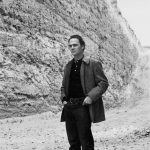
5. Walter De Maria
Born: 1 October 1935, Albany, California, United States
Died: 25 July 2013, Los Angeles, California, United States
Periods: Land art, Minimalism
Nationality: American
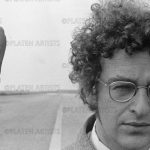
Land art- Introduction of these artists.
1st ANDY GOLDSWORTHY– Andy Goldsworthy is the artist of Land art movement who played a vital role in the Land art movement renaissance, the date of birth of this artist is 25 July 1956, and the place of birth is- Pob1.
This artist is known for/as Bradford College of Art (British sculptor, photographer and environmentalist). Due to regional effect, Paintings of this Land art artist show resemblance with these areas. The artistic qualification of this artist is- Bradford College of Art (British sculptor, photographer and environmentalist).
But still, it’s a beauty of this Land art movement that you may compare these artworks with each other- “Not A Cornfield,” “Little Sparta,” “City,” “Double Negative” and “Spiral Jetty.”
Notable works:- Sheepfolds 1996–2003 & Stone House 1997.
Qualification:- Bradford College of Art (British sculptor, photographer and environmentalist).
2nd ROBERT SMITHSON– The date of birth of Robert Smithson is January 2, 1938, this artist was born during the Land art period when the Land art movement was on the peak wherein Robert Smithson had played a vital role in this art movement.
The date of birth of this artist is JANUARY 2, 1938, and the place of birth is- POB2. The artistic qualification of this artist is- Art Students League of New York (American artist).
Notable works:- Spiral Jetty, 1970 & Bingham Copper Mine, Bingham, Utah.
Qualification:- Art Students League of New York (American artist).
3rd RICHARD LONG– This name also emerged during the Land art movement. The artwork demand of Richard Long is a little bit lesser than Andy Goldsworthy.
But the artworks of this artist (Richard Long) are also very beautiful. The artistic qualification of this artist is- Saint Martin’s School of Art (English sculptor).
Notable works:- Small White Pebble Circles, Tate Modern, London (1987) & White Water Falls, Garvan Institute, Sydney (2012).
Qualification:- Saint Martin’s School of Art (English sculptor).
4th MICHAEL HEIZER– The artistic qualification of this artist is- San Francisco Art Institute (contemporary artist). Michael Heizer is the artist of the Land art movement who also played a vital role in the Land art movement renaissance.
The date of birth of this artist is 1944, and the place of birth is pob4. This artist is known for/as San Francisco Art Institute (contemporary artist).
Notable works:- Levitated Mass, 2012 & Effigy Tumuli (1985).
Qualification:- San Francisco Art Institute (contemporary artist).
5th WALTER DE MARIA– The date of birth of this artist is October 1, 1935, and the artistic qualification of this artist is- University of California, Berkeley (American artist, sculptor, illustrator and composer). The artworks demand of Walter De Maria is a little bit lesser than Andy Goldsworthy.
But then also, paintings of this Land art artist remain in high demand.
Notable works:- Walter De Maria & Interview with Paul Cummings.
Qualification:- University of California, Berkeley (American artist, sculptor, illustrator and composer).
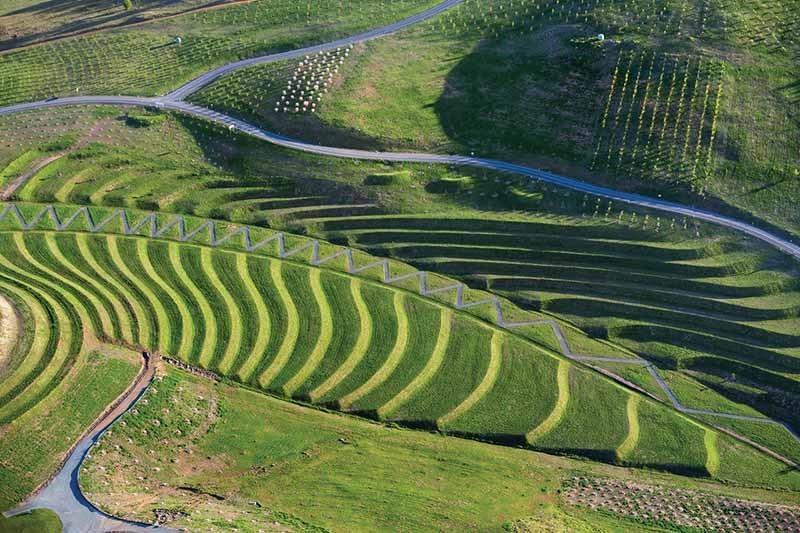
Land art- Related art movements
Land art, also referred to as Earth art or environmental art, emerged as a distinct movement in the late 1960s and early 1970s. While it is unique in its approach, Land art was influenced by and shares connections with various related art movements and practices. Here are some notable ones:

- Conceptual art: Land art and conceptual art share a common emphasis on ideas and concepts over aesthetic qualities. Both movements challenge traditional notions of art as an object and prioritize the underlying concept or message. Land artists often incorporate conceptual strategies, considering themes of time, space, and environmental concerns in their works.
- Minimalism: Land art intersects with Minimalism through its focus on simplicity, geometric forms, and the physical presence of artworks in space. Many Land artists were influenced by Minimalism and adopted minimalist aesthetics. Minimalism’s tendency to pare down forms and remove excess resonated with the Land art movement’s desire to create harmonious interventions within the natural environment.
- Environmentalism: Land art reflects an ecological consciousness and a concern for the environment. It emerged during a period of increased environmental awareness, highlighting the relationship between humans and the natural world. Land artists sought to raise questions about human impact on the environment, addressing issues of sustainability and resource exploitation.
- Performance art: Some Land artists incorporated performative elements, blurring the boundaries between art, action, and the natural landscape. Performances were used to activate the environment and engage with the audience, introducing a temporal dimension and emphasizing the experiential aspect of the artwork.
- Site-specific art: Land art often involves site-specific installations, where the artwork is created in response to a particular location or landscape. This approach aligns with the concept of site-specificity in contemporary art, where the meaning of the artwork is deeply connected to its physical and contextual surroundings. Land artists carefully selected and transformed natural sites, using the land itself as both canvas and inspiration.
These art movements and practices significantly influenced the development of Land art, shaping its concepts and approaches. They broadened the discourse around the relationship between art, nature, and societal and environmental concerns. Land art pushed the boundaries of traditional art spaces, inviting viewers to reevaluate their connection with the natural world and contemplate humanity’s role within it.
Land art- Key facts
Land Art, also known as Earth Art or Environmental Art, emerged as a distinct artistic movement during the late 1960s and early 1970s. It arose as a response to the limitations of traditional art spaces and a desire to explore the relationship between art and the natural environment. Here are some key facts about Land Art:
- Unique Interaction: Land Art involves creating artworks that directly interact with and are influenced by the natural landscape.
- Site-Specificity: Land Art places great importance on site-specificity. Artists carefully choose specific locations in nature for their artworks, considering the distinctive geographical, ecological, and historical characteristics of each site. The chosen site becomes an integral part of the artwork, shaping its form and meaning in a profound way.
- Monumental Scale: Many Land Art installations are characterized by their monumental size and large-scale presence. These artworks often encompass vast areas of land, transforming the landscape into an immersive artistic experience. The sheer scale of these installations creates a sense of awe and invites viewers to contemplate their own place within the expansive natural setting.
- Transience and Ephemeral Nature: Land Art often embraces the transient and ephemeral qualities of the natural world. Artists acknowledge and embrace the temporal nature of their artworks, recognizing that they may change, evolve, or even disappear over time due to natural processes like weathering and erosion. This aspect emphasizes the dynamic relationship between art and the environment.
- Minimalist Aesthetic: Land Art frequently adopts a minimalist aesthetic, characterized by simplicity, clean lines, and a reduction of forms. The emphasis is on using natural materials and creating a harmonious integration between the artwork and the surrounding landscape. This minimalist approach allows the inherent beauty of the environment to shine through.
- Environmental Consciousness: Land Art carries a strong environmental message, serving as a platform to raise awareness about ecological concerns and human impact on the natural world. Artists aim to provoke reflection and contemplation on our relationship with the environment, emphasizing the importance of sustainability and environmental stewardship.
- Non-Commercial Approach: Land Art emerged as a response to the commercialization and commodification of art. Many Land Art installations are intentionally situated outside traditional art spaces, challenging the notion of art as a commodity. This non-commercial approach fosters a more direct and unmediated experience with the artwork, placing greater emphasis on its intrinsic value and connection to nature.
- Documentation and Photography: Given the often remote and inaccessible locations of Land Art installations, documentation through photography and other media forms plays a crucial role in capturing and preserving the artworks. Photographs capture the essence of the artworks, allowing them to be shared, celebrated, and experienced by a wider audience while ensuring their enduring legacy.
- Lasting Influence: Land Art has had a significant and enduring impact on the art world. It pushed the boundaries of artistic expression, challenged traditional art forms, and inspired subsequent generations of artists. Its emphasis on site-specificity, environmental consciousness, and the integration of art with nature continues to influence and shape contemporary art practices.
These key facts provide a comprehensive overview of Land Art, highlighting its unique interaction with the natural landscape, the significance of site-specificity, the monumental scale of the artworks, their transience and ephemeral nature, the minimalist aesthetic, environmental consciousness, the non-commercial approach, the importance of documentation and photography, and the lasting influence of the movement on the art world.
Land art- People also search for
Top artists (5):-
Top artworks (5):-
Related art movements(3)


